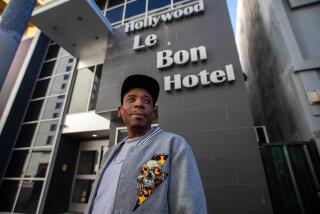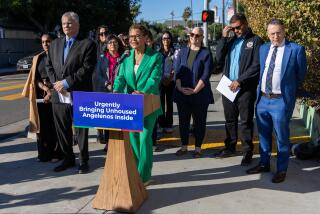Editorial: Garcetti’s plans for homeless shelters raise as many questions as they answer
In his state of the city speech Monday, Mayor Eric Garcetti eloquently conjured the image of a child who sees a homeless woman sleeping on a bench and asks whether she has someone to take care of her. “The answer is yes,” Garcetti said. “The city of Los Angeles is going to take care of her and bring her home.” Certainly, the new plans that the mayor laid out in his speech for financing shelters across the city of Los Angeles are a start toward finding at least temporary housing — about 1,500 beds, he estimates.
But his plans raised as many concerns as they addressed. What kind of shelters are these? Even if each shelter bed serves about four people over the course of a year — as he hopes — what about the rest of the 25,000 unsheltered homeless people in the city? And what’s the exit strategy for the hundreds or thousands of people who do get into shelters but are expected to leave after half a year at most?
These questions don’t mean the mayor’s plans are unworkable. They just need answering before the city proceeds. And Garcetti and the City Council need to make sure they don’t take their focus off the ultimate goal here: creating permanent housing, which is the only way to make a real dent in homelessness.
The mayor’s sense of urgency is certainly appropriate given that the homeless crisis in the city has grown wildly out of control. But with more than 34,000 homeless people living in shelters and in their cars and on the streets of Los Angeles on any given night, 1,500 new beds is a drop in the bucket.
With more than 34,000 homeless people on any given night, 1,500 new beds is a drop in the bucket.
Garcetti said Monday that he would declare a “shelter emergency” on Tuesday to remove some of the bureaucratic red tape that might hamper speedy shelter construction. He proposed about $1.3 million in city money for each council district that provides an additional 100 shelter beds. Beyond that, Garcetti said that it will be up to the council members to be creative about what the shelters will look like. He also promised to dramatically increase the number of outreach workers on the streets to persuade people to accept shelter. In shelters, people would get the counseling and other help they need to transition into permanent housing.
At least one of the challenges will be creating shelters that don’t replicate the old-school, cot-filled armories that require people to leave in the mornings and line up again in the afternoon in hopes of getting another bed. Garcetti said the city would focus on shelters that allow people to have a bed for longer periods, as well as storage space, and some privacy — and allow for them to bring their pets and their partners. That’s important if we want homeless people to use the shelters, and we do.
The city should also continue to try to lease motel rooms on short-term and long-term bases for the homeless.
In exchange for accepting the shelters, Garcetti promised neighborhoods that they would get more street cleaning and fewer encampments. But persuading homeless people to leave encampments can take patient outreach work — and, of course, the housing or shelter to move them into. The number of unsheltered homeless people in each district surpasses the number of shelter beds that Garcetti is expecting each district to come up with. So what happens to the remaining people on the street? If there aren’t enough shelter beds for them, they should not be shooed away by sanitation workers relentlessly cleaning the streets day after day in an attempt to discourage homeless people from returning. Because they’ll just move to a different corner.
Garcetti noted that the city had housed 30,000 people during the past four years. And yet, he said, he didn’t expect the new homeless figures next month to be any lower than they were last year. When asked why, Garcetti lamented that the thousands of people coming out of the criminal justice system and landing on the streets with nowhere to go contributes to the growing numbers. But if that’s the case, then he needs to work with — or get in the face of — county and state officials, exhorting them to do a better job of making sure people coming out of jails and prisons have a place to live.
We need permanent housing, and we need to find ways to build it faster. But Garcetti is also right that, in the meantime, we need shelters to fill the gaps. The campaign against homelessness must be waged on many fronts.
Follow the Opinion section on Twitter @latimesopinionand Facebook
More to Read
A cure for the common opinion
Get thought-provoking perspectives with our weekly newsletter.
You may occasionally receive promotional content from the Los Angeles Times.






